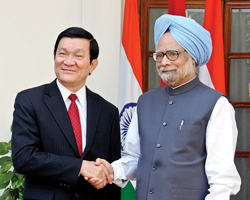RAJ KANWAR, Contributing Editor, South Asia
ONGC Videsh Ltd. (OVL), the overseas arm of India’s state-run oil major Oil and Natural Gas Corp., entered a historic cooperation agreement Oct. 12 with PetroVietnam, the national oil company of the Socialist Republic of Vietnam. The contract, signed by PetroVietnam Chairman Phung Dinh Thuc and OVL CEO and Managing Director D. K. Sarraf in the presence of Vietnamese President Truong Tan Sang and the Indian Prime Minister Manmohan Singh, marked a new high point in relations between these two countries, but has raised the ire of Vietnam’s neighbor China, which claims almost all of the South China Sea and resents the increased presence of another giant energy-consuming nation in its backyard.
The three-year agreement aims at developing long-term cooperation between the two oil and gas companies. Among its provisions, it stipulates an exchange of working visits by senior officials and specialists and sets guidelines for new E&P investments, as well as expansion and operation of existing projects. It will also cover activities relating to refining, dispensation and transportation in Vietnam, India and third countries.
ONGC and Hydrocarbon India Ltd. (the previous incarnation of OVL) were among the first foreign companies in the world to take an active part in the growth of Vietnam’s oil and gas industry. The cooperation between the two countries and these companies, dating back to the 1980s, led to the first contract for the development of gas fields in block 06-1 in May 1998. The development of these gas fields is of much national and strategic importance to Vietnam since they contribute about 50% of its gas needs. This cooperation was further expanded when OVL was awarded two exploration blocks (127 and 128) in Vietnam’s Phu Kanh basin in June 2006. This deal was conducted through regular bidding processes.
The two companies are now considering extending the scope of their cooperation to third countries. Vietnam’s upstream oil and gas sector has been attracting a host of IOCs in recent years, as well as Asian NOCs. OVL, too, is keen to enhance its investments in Vietnam’s offshore sector.
 |
| Vietnam’s President Truong Tan Sang (left) shakes hands with Indian Prime Minister Manmohan Singh during the signing of the cooperation pact. |
|
As the Indian and the Vietnamese oil majors signed this historic agreement, the Chinese official media spewed fire. The Global Times, in particular, condemned both India and the Vietnam, calling the proposed exploration projects “reckless” and insinuating that India had an ulterior motive of collecting political “bargaining chips” against China. In its fire-and-brimstone editorial, the Global Times warned that “China can send non-military forces to disturb their work, and cause dispute or friction to halt the two countries’ exploration. In other words, China should let them know that economic profits via such cooperation can hardly match the risk.”
The China Energy News, published by Communist Party mouthpiece the People’s Daily, also criticized the deal, warning that “India is playing with fire by agreeing to explore for oil with Vietnam in the disputed South China Sea,” and calling on the South Asian nation to reconsider the pact.
Particularly irksome to the Chinese media was the fact that, a day before the agreement was signed, Vietnam’s Communist Party chief was in Beijing, jointly laying out with Chinese officials the ground rules for solving their contentious maritime claims.
Emboldened by its growing military and economic muscle, China has been displaying a belligerent stance toward all of its neighbors and summarily dismissing their respective territorial and other claims. Incidentally, Vietnam still continues to claim the Paracel Islands (Xisha Islands in Chinese and Hoàng Sa Islands in Vietnamese), from which the Chinese expelled South Vietnamese forces in 1974. It also claims the Spratlys in the south, where in 1988 as many as 70 Vietnamese sailors were killed in clashes with the Chinese.
Vietnam, China, Philippines, Brunei, Malaysia and Taiwan have all staked conflicting claims over parts of the South China Sea, which is both rich in potential oil and gas reserves and interspersed with key shipping lanes, making it a potential flash point for aggravated conflict among all these countries. India’s agreement with PetroVietnam is likely to further stoke that fire.
Meanwhile, in another twist to the South China Sea disputes, Chinese Prime Minister Wen Jiabao was enigmatic at the summit meeting of Association of South East Asian Nations (ASEAN) on Nov. 20. He told the assembled delegates from the 10 ASEAN countries and their eight partners including China, India and the United States that the summit was not “an appropriate place to discuss the South China Sea issue.” In the very next sentence, the Chinese Premier, however, added that it was impolite not to reciprocate. It was an obvious reference to Washington’s call with Philippines and Vietnam to discuss the dispute at the summit originally intended for regional development discussions. 
THE AUTHOR
|
| RAJ KANWAR has been a journalist, a public relations and advertising professional and a businessman at different stages during the course of his 55-year career. He has weekly columns in Indian national dailies to his credit as well as the book “Upstream India,” an ONGC-commissioned history of the company. / rkanwar_in@yahoo.co.uk |
|



